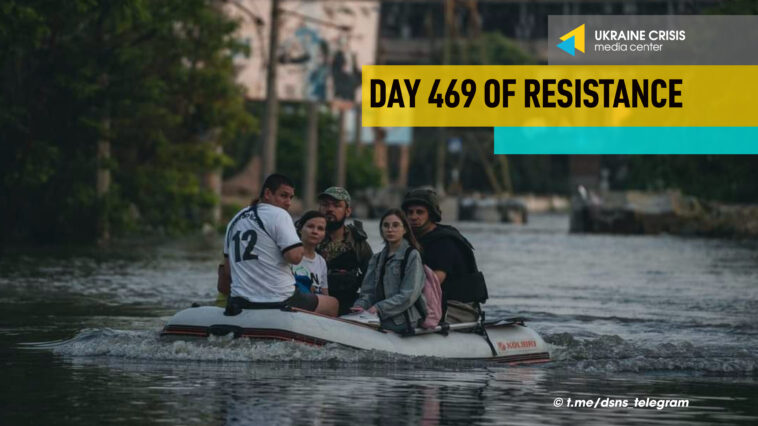Around 30 settlements inundated, Russians fail to mobilize evacuation efforts on left bank
Water levels rose by 5.5 meters. The speed of flood waters has slowed down, but water levels may rise by seven meters.
Russian-installed authorities failed to conduct evacuations from towns and villages on the left bank of the Dnipro, leaving residents of the occupied areas stranded.
Around 10,000 hectares of agricultural land on the right bank of the Dnipro and several times more land on the left bank of the river, would be flooded and could turn into deserts. The destruction of the Kakhovka dam and hydroelectric power plant has left 94 per cent of irrigation systems in Kherson region, 74 per cent of those in Zaporizhzhia region, and 30 per cent of those in Dnipropetrovska region without water.
The losses of the fishing industry could reach 95,000 tons, or around UAH four billion (approx. USD 108,000). According to preliminary calculations, a total loss of biological resources will amount to UAH 10.5 billion (approx. USD 284,000). Negative effects from the devastation of aquatic biological resources will stay for several years.
The blowing up of the Kakhovka hydroelectric power plant makes it impossible to supply water to Crimea in the coming years, Secretary of the National Security and Defense Council Oleksiy Danilov said.
Ukraine’s Health Ministry has warned that chemical substances, infectious agents from cemeteries, toilets, and waste dumps could get into wells and water bodies in the flooded areas.
After the collapse of the Kakhovka hydroelectric power plant, in Kherson region, the Russians pulled back from the Dnipro by five to 15 kilometers. They continue to launch attacks on the right bank of the river amid evacuation efforts, the Operational Command South said.
Rebuilding a plant could cost Ukraine around USD one billion and last at least five years, Minister of Economy Yulia Svyrydenko said.
Some 29 towns and villages have been inundated, of which 19 are in the government-controlled area, and 10 others are occupied, Minister of Interior Ihor Klymenko said.
As of 5 p.m., almost all 1,900 residents from areas affected by flooding, were evacuated, the Ministry of Internal Affairs said.
Russian attack on Kakhovka HPP puts Zaporizhzhia NPP at safety risk. Ukraine in Flames #454
The act of undermining the Kakhovka Hydro Power Plant (HPP) by russian forces poses a significant threat to the Zaporizhzhia Nuclear Power Plant (NPP), despite the current situation being under control. The water supply from the Kakhovsky Reservoir is essential for providing power to the turbine capacitors and safety systems at the nuclear plant. At present, the available video and satellite images do not provide conclusive evidence regarding the extent of the water level reduction in the Kakhovsky Reservoir following its detonation by the russian occupiers. Watch Ukraine in flames #454 to delve into the unfolding situation regarding nuclear safety and assess the potential risks to the nuclear infrastructure following the russian attack on Kakhovka HPP.
Guests:
- Valeriy Chaly, Ambassador of Ukraine to the USA (2015-2019), Chairman of the Board of Ukraine Crisis Media Center
- Olha Kosharna, Nuclear Energy Expert
- Yuriy Kostenko, Former Minister of Environmental Protection and Nuclear Safety of Ukraine, Former Member of the Commission on Nuclear Policy and Environmental Safety
- Archil Tsintsadze, expert en politique de sécurité
- Valeriy Chaly, ambassadeur d’Ukraine aux États-Unis (2015-2019), président du conseil d’administration de l’Ukraine Crisis Media Center
- Ihor Seletskyi, directeur exécutif de l’ONG “Euroatlantic Course”
- Volodymyr Tsybulko, expert politique




